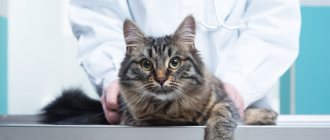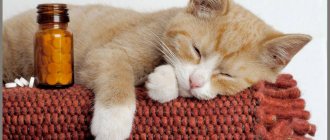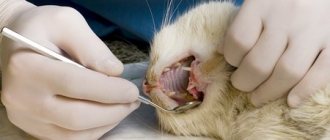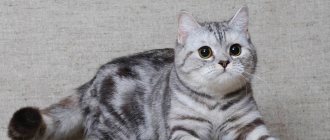Many owners tend to think that caring for a cat's teeth is unnecessary. And they don’t suspect that dental problems occur in cats no less often than in people. Caries is rare in cats, but tartar is a serious problem for many. The owner must know how to brush a cat’s teeth and how to teach him to do it. Regular cat oral hygiene not only protects against the formation of lime deposits, but also significantly reduces the risk of developing serious dental problems: gingivitis, stomatitis, periodontitis.
Using home remedies for cleaning
Ideally, oral hygiene involves the use of special products designed for pets. But they are not always at hand.
At home, the procedure can be carried out using wine and soda. These products help remove food debris and stone formation.
First, the teeth are moistened with wine, then soda is applied. The components react with each other and purification occurs.
How much does it cost to have your cat's teeth cleaned at the vet?
Many owners, instead of brushing their cat’s teeth themselves, prefer to have a specially trained specialist do the job. Average prices at Moscow veterinarians:
- stone removal with ultrasound (excluding anesthesia) – from 1500 rubles;
- complete sanitation of the oral cavity (with removal of damaged teeth) – the cost starts from 4,500 rubles.
Cat care is essential. By teaching your pet to brush its teeth, you can avoid serious oral problems throughout its life.
Necessary tools, materials
When choosing equipment, you need to take into account the pet's temperament. If the cat is calm and trusts its owner, then it will be possible to do without a brush. If the animal is aggressive and doesn’t like having fingers put in its mouth, you will have to choose non-contact hygiene products.
The first thing you need to do is choose a toothbrush.
There are two types of tools:
- fingertip;
- with a handle.
The fingertip makes it possible to completely control the cleaning process, but the pet can bite the owner. A brush equipped with a handle is considered safe.
It must be used carefully so as not to damage the animal’s gums.
A toothbrush that is intended for humans cannot be used for a cat, because the bristles on it are much stiffer and can scratch the delicate mucous membranes. As a last resort, you can use a baby brush . Its head is small and the bristles are much softer.
Cleaning is carried out with a special paste or simple tooth powder. The main thing is that the product does not have a strong smell or taste, otherwise the animal will not accept the procedure (cats do not like the smell of mint.
Cat hygiene products have a meat or fish aroma.
Let's go to the clinic
If the owner does not dare to carry out the procedure on his own or it has become obvious that the cat has already developed tartar, a visit to the veterinarian will be required. This is an expensive procedure; for the animal itself, it is most often associated with a stressful situation. You also need to take into account that there is a risk of falling into the hands of an inexperienced veterinarian, who can injure the gums and damage the enamel. Therefore, choosing a specialist must be approached responsibly and seriously.
Most often, clinics offer mechanical cleaning. It involves the use of special devices with several attachments. The cat receives local anesthesia and a mild sedative injection. The procedure is carried out quickly and painlessly.
If you have a choice, it is better to prefer ultrasonic cleaning. This is not only a more gentle technique for teeth, but also an opportunity to perfectly whiten darkened teeth. But this option is not suitable for “problem” cats – those with heart or vascular diseases.
Features of preparation
First you need to take your pet to the vet. The doctor will conduct an examination, give recommendations on the choice of hygiene products, and if caries is detected, he will clean it using ultrasound.
When preparing your pet for the procedure, you need to adhere to several rules:
- Introduce the cat to the brush and let him play with it a little.
- A few days before the scheduled procedure, offer to try the paste. The animal will get used to the new taste and will not be afraid during basic manipulations.
- Perform the procedure when the cat is fed, healthy and in a good mood.
- For the first time, it is better to use cotton swabs instead of a brush.
Frequency of procedures
It is better to accustom cats to brushing their teeth from a young age - in this case, the animal will get used to it faster and in the future will perceive the procedure much more calmly. Therefore, it is advisable to begin acquaintance with a brush and paste from the moment all baby teeth appear - at 8-12 weeks. For such a baby, procedures 1-2 times a month will be enough, but with mandatory regularity. After changing the dentition, you can brush more and more often, gradually approaching the regularity recommended by veterinarians - 1-2 times a week.
A mandatory step in caring for your cat’s teeth should be systematic visits to the veterinary dentist - once a year will be enough. The specialist will examine the oral cavity and, if necessary, give additional recommendations or make adjustments to the actions taken by the animal owner regarding the health of his teeth.
Basic cleaning rules
To properly brush your pet’s teeth, you need to follow these recommendations:
- Perform actions without haste. Talk to the cat, stroke it.
- An aggressive animal should be wrapped in a towel and asked for someone to hold it.
- Use a separate brush for each cat.
- The duration of the procedure is a maximum of forty seconds.
- Excessive efforts should not be made. The actions are careful and unhurried, so as not to injure the animal.
- Manipulations need to be performed at the same time, this way it will be easier for the pet to get used to them.
Algorithm
Animal oral hygiene involves performing the following actions:
- Apply a little paste to the brush. The cat is placed between the legs (he should not see the owner or feel discomfort).
- One hand is placed on the pet's head. The index finger and thumb are at the corners of the mouth.
- Press on the area between the teeth - the animal will open its mouth. It is impossible to grab the lower jaw, moving it down.
- The upper lip is lifted with your fingers and cleaned on both sides.
- The brush is held at an angle of about 45⁰. Sweeping movements are performed from top to bottom. You cannot move horizontally.
- Gradually the mouth opens more. This way it is possible to get to the back teeth.
- The external and internal surfaces are cleaned. After this, proceed to the chewing part.
- Each side is cleared for ten seconds.
- It is necessary to ensure that the bristles do not get on the gums, otherwise they will begin to bleed.
- The gums are massaged with a special brush, movements are performed from top to bottom, then in a circle. Actions are soft and smooth.
- After finishing the basic manipulations, do not forget to praise your pet, stroke it, and give it a treat.
Instructions on how to brush your teeth
Cleaning a cat's teeth
How to trim a cat's claws: options at home
Pets need to clean their mouth at least 2 times a week.
Special gels and powders are used daily for 2-3 months, then take breaks. If a cat has inflammation in the mouth, special antiseptic and healing agents are needed. A veterinarian can prescribe them. It is not recommended to buy cleaning products yourself in such cases.
How to brush your cat's teeth (step by step instructions):
- Choose the right moment when the animal is in a good mood and relaxed.
- Wash your hands with disinfectant soap.
- Prepare cleaning preparations and necessary equipment.
- Apply the paste to your toothbrush. Place the cat in a comfortable position. It is best if he does not see the owner, but sits with his back to him. The pet should be relaxed. If he is uncomfortable, it is better to change position.
- Hold the kitten's head with one hand and place your thumb and index fingers in the corners of its mouth.
- You will need to apply a little pressure on the cat's gums to force him to open his mouth wider. In this case, you do not need to make sudden movements; you can get scratches and bites.
- Place a brush with paste into the oral cavity and, with gentle movements, first move along the upper row of teeth, then along the lower one. It is necessary to hold the brush at an angle; it is best to make sweeping movements.
To get to the furthest teeth, you need to try to open the cat's mouth even more.
To destroy all germs, you need to brush your teeth not only from the outside, but also from the inside. At the same time, you should not linger on each of them for more than 15 seconds at the initial stage, as this can lead to bleeding. In addition, you can brush along the chewing surface to remove germs and food debris.
You should try not to touch your cat's gums while cleaning, otherwise they may bleed and cause him pain. In such cases, the procedure will be interrupted.
After completing the process, it is recommended to do a small massage of the oral cavity using a special brush or finger attachment. This will help the animal relax. To consolidate the result, you can use dental sprays. They have antiseptic, anti-inflammatory and antibacterial properties, which help reduce the risk of infection and plaque development.
Additional information: 30-40 minutes after the procedure, you need to praise the animal for restraint and treat it with its favorite treat.
Stroking the cat after the procedure
Features of brushing teeth in small kittens
It is necessary to teach hygiene procedures from an early age. The kitten first gets used to the fact that the owner holds his hands near his mouth. Then they begin to feed the baby by hand, gently touching the teeth.
When the kitten gets used to these actions, they begin to teach him to clean. In the first stages, the teeth are wiped with a damp cloth, performing smooth circular movements.
By four months, the animal calmly reacts to such manipulations.
At the age of four months, the child begins to learn to eat pasta. Squeeze the product onto your finger, let it smell and taste it.
After such an introduction, apply the paste to the brush and try to brush the front teeth. The processing area gradually increases. Next, cleaning is carried out as for adult cats.
Modern hygiene products for cats
However, not every animal will like the classic method of cleaning, causing further fear and even aggression. In such cases, it is possible to replace the toothpaste with a special gel.
.
There is no need to apply it directly to your teeth: just add it to food or water. Some cats eat it from their hands, as it has a pleasant aroma for pets.
Gels have a weak cleaning property; they remove only light plaque.
The solution to the problem will also be the simultaneous use of both the gel and cleaning treats - dental toys
(bones, ears, etc.).
These two methods have one serious drawback: they only remove plaque without affecting the deposited tartar. It is formed during the life of microorganisms, deposits of mineral salts - if the plaque is not removed within a week.
Cleaning your pet's teeth
What to do if your pet resists
If an animal categorically refuses to perform hygiene procedures, you should not force it. Such actions are stressful for the cat .
It is recommended to select alternative cleaning options:
- Liquid paste. When used, the number of pathogenic microorganisms is reduced. The product is used according to the instructions: it is diluted with water (1 tsp of paste requires 1 glass of liquid), the resulting solution is added to drinking water. You should not use the product often because it can affect tooth enamel.
- Periodically replace soft food with dry food. They promote cleaning and massage the gums. Cats that constantly eat dry food should be given types that are designed to clean the mouth. Their granules have a unique structure and help remove plaque.
- It is recommended to give cartilage to pets that eat natural food (the consumption of tubular and flat bones is unacceptable). Raw meat is cut into pieces without chopping.
- You can purchase bones impregnated with an agent that prevents the formation of tartar.
- Special dental toys are purchased.
- You can add a small amount of toothpaste to food and apply it to toys.
- Use a spray that has an antibacterial effect. It is injected into the oral cavity after each meal.
Some care tips
There are pets that stubbornly refuse to have their teeth treated. Owners can be advised to purchase sticks or special toys. Wooden sticks are impregnated with catnip, so cats chew them with pleasure. Dental bones are also available for sale. Regular edible bones and cartilage will do. But they must be large so that the cat gnaws on them rather than swallowing them. Tubular and small sharp bones are prohibited.
Impregnated rubber toys are no less effective.
Veterinarians recommend reviewing your pet’s diet by adding dry food or special dental food. Inflammation of the gums is relieved with a special gel.
Maintaining hygiene, prevention and regular examinations will help to avoid major dental problems, and your cat will be in a good mood.
Why dental care is important
Just a couple of decades ago, caring for cat teeth in our country was perceived as a fad. Now both veterinarians and breeders are talking about the need for regular cleaning of the pets’ mouth. Why is it important to monitor the condition of your cat’s teeth?
After eating, plaque forms on the surface of the tooth enamel. If it is not removed, it will eventually transform into stone. The latter not only does not look aesthetically pleasing, but also leads to gum inflammation.
Against the background of inflammation and proliferation of pathogenic microflora, the entire body begins to suffer. The cat develops problems not only with the oral cavity, but also with the stomach, liver, and intestines.
Due to the large number of pathogenic bacteria, immunity is reduced. The animal suffers from regular colds and becomes more susceptible to infections. Which increases the risk of contracting feline leukemia or immunodeficiency virus.
Without regular cleanings, the enamel is damaged by caries. What causes teeth to crumble or break off. In advanced cases, they begin to stagger and the animal feels uncomfortable eating. Eventually, the diseased teeth fall out and the cat requires a special diet of pureed food.











